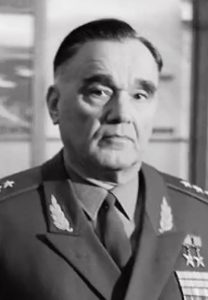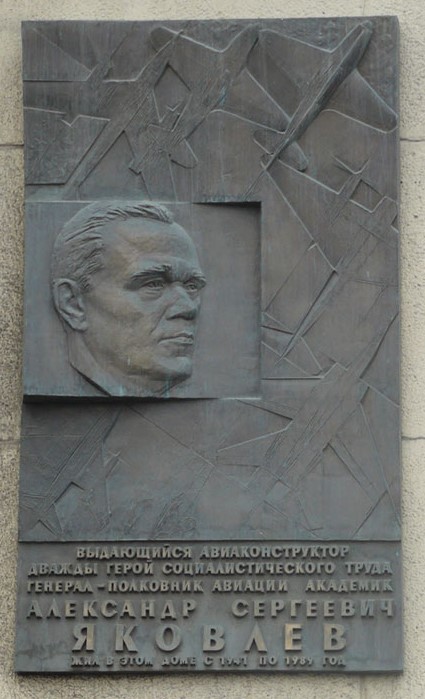Aleksander Sergeevich
Yakovlev
1906-1989

Aleksander Sergeevich Yakovlev was the Soviet designer of aviation equipment, chief designer of the Design Bureau No. 115 of the People’s Commissariat of Aviation Industry of the USSR, Moscow, General Designer of the Design Bureau No. 115 of the Ministry of Aviation Industry of the USSR, the twice Hero of Socialist Labor. He was born in Moscow in the family of an employee. At school, Aleksander Sergeevich Yakovlev showed an interest in technology and, in particular, in aviation. In 1921, he built a flying glider model and successfully tested it in the school hall. Since 1924 Yakovlev was first a worker, then a motorist of the flight detachment of the Academy of the Air Fleet (AVF) named after N.E. Zhukovsky. In the same year, he built his first aircraft, the AVF-10 glider. Despite numerous requests and appeals, he was not accepted to the academy, due to “non-proletarian origin.” In 1927 Yakovlev built his first aircraft – AIR-1 (VVA-1). In July 1927, the first Soviet world records were set on this aircraft – the range (1,420 km) and duration (15 hours 30 minutes) of flight. For these achievements A.S. Yakovlev was enrolled as a student in Air Force Academy out of competition. During his studies at the Academy, he did not stop building airplanes. In 1927-1931, under his leadership, 8 types of aircraft were created – from AIR-1 to AIR-8, one of which (AIR-6) was built in a large series. In 1931, upon graduation from the Academy, he entered the Menzhinsky Aircraft Factory No. 39 as an engineer, where in August of the following year he organized a group of light aircraft – his future design bureau. A group of enthusiasts, working under the leadership of A.S. Yakovlev, achieved recognition in January 1934. It was transferred from Osoviakhim to the state aviation industry as an independent design and production bureau, which soon became Plant No. 115. The first aircraft created at the new location, the AIR-9, was shown at the Paris Aviation Salon in the autumn of 1934. Later, on its basis, the UT-2 aircraft was created for initial training for Air Force flight schools and aero clubs, produced in 1938-1948. In 1935 A.S. Yakovlev became the chief designer. In subsequent years, the Design Bureau created several lighter sports aircraft: UT-1, AIR-11 and AIR-12. In 1939 the Design Bureau built its first combat vehicle, the twin–engined bomber BB-22 (Yak-2 and Yak-4), which speed exceeded the speed of the best fighters of that time. The Yak-2 and Yak-4 were built serially. In January 1940, he simultaneously worked as the Deputy People’s Commissar of the Aviation Industry for experimental aircraft construction and science. On January 13, 1940, the I-26 (Yak-1) fighter took to the air. The aircraft was highly appreciated, and the chief designer became one of the first Heroes of Socialist Labor. By the Decree of the Presidium of the Supreme Soviet of the USSR of October 28, 1940 for outstanding achievements in the field of creating new types of weapons that raised the defence power of the Soviet Union, Aleksander Yakovlev was awarded the title of the Hero of Socialist Labor with the award of the Order of Lenin and the Hammer and Sickle gold medal. During the Great Patriotic War, the Yak-7 (1941), Yak-9, Yak-3 (1943) and over 30 of their serial variants and modifications were created on the basis of the Yak-1 – more than 30 thousand aircraft in total. They accounted for two-thirds of the fighters produced during the war. Each “Yak” had a number of modifications, differing in the best characteristics. The replacement of wood in the construction with metal, the improvement of aerodynamics allowed to increase the flight speed. The last modification of the Yak-3 had it up to 720 km/ h, it was also the lightest fighter of the Second World War. The armament was strengthened, from 20 mm guns on the Yak-1 to 37 mm and 45 mm on the Yak-9. The flight range increased, up to 2,200 km from the Yak-9DD. From 1956 until his retirement, A.S. Yakovlev was the general designer of the Design Bureau. In the post-war period, aviation was re-equipped with jet technology. The Yak-15 fighter became the first jet aircraft to enter service in the USSR. It was followed by the Yak-17UTI, Yak-23, Yak-25 – the first Soviet all-weather interceptor, the high-altitude Yak-25RV, the first supersonic reconnaissance Yak-27R, the family of supersonic Yak-28 aircraft, including the first Soviet supersonic front-line bomber. Landing craft entered service – the Yak-14 glider and the Yak-24 helicopter – the most lifting in the world in 1952-1956. By the Decree of the Presidium of the Supreme Soviet of the USSR dated July 12, 1957 Aleksander Sergeevich Yakovlev was awarded the second Hammer and Sickle gold medal for outstanding achievements in the creation of new aviation equipment and labor heroism shown at the same time. He became the Hero of Socialist Labor twice. On August 21, 1984, A.S. Yakovlev retired at the age of 78. In total, over 200 types of aircraft were created under his leadership, including more than 100 serial ones, on which 86 world records were set at different times. He wrote several books: “Stories of an aircraft designer”, “The purpose of life (notes of an aircraft designer)”, “50 years of Soviet aircraft Construction”, “Soviet aircraft”.
Address: Moscow, Leningradsky ave., 69, p. 1

